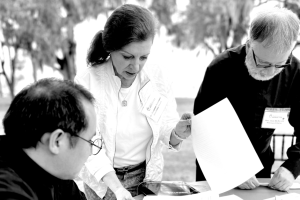
In 2016, theologian Jeff Keuss joined a national research effort funded by the Lilly Endowment to explore a pressing question: Why were so many young adults turning away from religion? “It wasn’t a million-dollar question,” Keuss says. “It was a $55 million question.” He was one of 12 principal investigators studying the shifting religious landscape among 22- to 29-year-olds—the largest demographic cohort at the time, but the least likely to attend churches, mosques, or synagogues.
The project, which became the Young Adult and Emerging Adult Innovation Hub, has spanned nearly a decade and tracked dramatic changes, including the COVID-19 pandemic and the coming of age of Gen Z and Gen Alpha. Their findings were surprising: Young people are returning to religious communities that prioritize relationships, justice work, and shared leadership.
Eventually, the first five years of research (the project wraps up in 2026) became a book, Defiant Hope, Active Love (Eerdmans), which looks at what young adults across ethnic, racial, and religious backgrounds are looking for in religious communities.
The book’s title is a nod to The Brothers Karamazov, where Father Zosima insists that people crave “active love,” not merely platitudes. “That’s how we have defiant hope in the world,” Keuss says. “That means we live with the burden of hope, because we are loving well.” He connects this with young adults’ search for connection in an age of isolation. “It’s an incredible thing to realize that in every room where I walk, the communion of saints walks with me. That empowers me to that active love.”
Was there anything that surprised you in the course of this research project?
In addition to national surveys, our research involved a lot of qualitative research collection: We did a lot of sitting in apartments with people with Yeti coolers full of La Croix. We went to CrossFit gyms, mountaineering clubs—wherever young people were hanging out—and we asked people to describe their experiences with churches and faith communities.
Consistently, we heard positive reflections. Many spoke of the good work churches do, how their parents had grown in their faith communities, and how they themselves had been catechized in ways they appreciated.
I think that comes as a shock to many older adults and clergy. Young adults really like religious organizations. They’re not trying to burn down institutions of religion. They’re not trying to walk away and do something totally secular: They actually really appreciate the work churches have done.
There’s this picture that young adults just don’t like church. And that’s not true. Young adults have a lot of curiosity about religious organizations. Now, the big asterisk on that is that they really have no time for hypocrisy or secrecy. They have no time for any unwillingness to talk about the big questions. So they appreciate the potential of religious organizations and their legacy, but the question about whether they are useful in the here and now is a different question.
Young adults want churches to look at them fully, see that they are people who have a lot to offer, and they’re not children who should just be put to work with the youth group. We have young people who are managing multimillion-dollar accounts in their work, and then as soon as they show up at a church, they’re asked to work in the nursery. Which is a beautiful ministry, but they have all these other things they could offer.
I think many parishes have this assumption that even though young adults might leave for a while, they’ll come back when they get married or have kids. Is this an accurate assumption?
I’ve heard that as well, this idea that, well, when people get older, they’ll realize the importance of church. And it’s true, we do see a bump where people return to church. We’ve seen this since the 1970s—people will walk away for a while because they go to college, they get their careers going, they get very busy. They don’t have time to go to Mass. And then they have children, and there’s this sense of, “How do I catechize them? How do I raise them morally and spiritually?” And so people will return through what I call the back door, through children’s programs. That’s still true.
However, at the same time, there is also a decrease in interest in traditional marriage. Young adults are not getting married in the numbers they used to. So if a church focuses on the language of this traditional family as the particular way young people are going to be included in a church community, that’s deeply problematic and honestly painful for a lot of young adults. They have friends, they care a lot about religion, but they just don’t see this particular part of their identity in the way their parents or their grandparents did. One of the things we’ve seen is that while young adults really do want to participate, if the church at its essential core centers a particular type of family, then they will feel secondary to that community.
What does draw young people back then?
Mission. If a church has a very strong sense of purpose, beyond merely catechizing its own members, and is externally focused, then young adults want to show up. They want to see that churches are considering what it means to love your neighbor and have great and strong examples of that.
Also, quite frankly, young adults want mentors. This was something else surprising we found. A lot of older adults will say, “Well, young people don’t want to listen to me. They have their own things.” But that’s not true. One young adult in the Pacific Northwest told me, “I love going to church, because every person is walking around like a big library. These people have this wealth of experience, knowledge, and wisdom, and I want to learn from them about what it means to grow up.”
Churches are one of the few places where we have multigenerational communities anymore. Places of work, gyms, what we call “third places” where people gather—all of these tend to be very demographically homogenous. But young adults want to have the experience of being around 85-year-olds and 5-year-olds, and church communities are one of the few places where you can have this.
This reminds me of the idea that effective outreach involves some sort of young adult group where the 18- to 35-year-olds can meet separately.
This definitely happens, and I think you can say that this has been a trend since the Second Vatican Council. That led to this sense of constant renewal, where the church is constantly trying to say, “OK, what’s our message, what’s our mission? How do we take hold of the culture in which we are embedded? How do we make the gospel new and refreshing and speak the language of that time?”
Those are all good questions. But what happens is that you get churches chasing after what I call the “light show,” meaning that they want to have big, bright, expensive things. They want cool music, they want fog machines, they want to project things on screens, because they think the new generations will really like that.
Now there are very attractive church ministries that use a lot of technology and use it well. But generally speaking, if you look at the technological efficiencies of a church, things like a robust social media platform or use of technology during the service might attract a certain bandwidth of person, but what keeps people in churches is very basic: that they have a real sense of hospitality. In other words, that throughout the week there are multiple ways a young adult can participate in the possibility of relationships through things like dinners, small groups, basketball teams or walking groups, etc.
The churches that get very cringey are churches that see someone in their 20s, drag them in, and try to hold on to them. Young adults have this fear almost that if they show up somewhere new they’ll be grabbed onto. Instead, just create easy invitations to hospitality.
A lot of young adults are actually looking for smaller, not larger communities. The massive 5,000-member congregations still exist in some urban areas, but generally speaking, the parishes that are growing are the ones with 75 to 100 people. These smaller communities mean it’s easier to see the possibility of relationship; the anonymity of large communities can leave people as spectators. People are looking for more intimacy and for a church where people know their name.
This might speak to the appeal of radical traditionalism in Catholicism—a turn away from the flashy modern liturgy to something that is smaller and more “authentic.”
In Defiant Hope, Active Love I bring up the distinction between traditional and traditionalism. Traditionalism is a codified, almost caught-in-amber view of what the church has to be for all time. Traditionality, however, is constantly asking, “What is the new thing God is requiring of us today?” There’s a trajectory to the church as opposed to it being a stake in the ground that will never change. The church has always been a road to Emmaus. It has always been a journey with new people coming in, picking up the tradition, and asking, “How do I live this out today?”
Traditionalism asks you to come into the church and adhere to certain things, to leave behind the now and constantly focus on the past. And there’s something beautiful about that, particularly for young adults who are looking for a deep history. One of the reasons why this sort of religious expression appeals to young adults is that they are tired of flippancy and little aphorisms: They want deep religious learning. They want to be a part of something bigger and deeper than themselves. And the beauty of liturgical traditions such as Orthodoxy or Catholicism is that it gives a sense of that history.
Young adults want both guides and guardrails. They want to know where they’re going but also want guardrails that tell them how they’re supposed to navigate the world. Traditionalism is all guardrails; it tells you what not to do. Traditionality is guiding; it follows where God takes you and helps you explore that. I think this is a distinction that needs to be made in communities, because young people want roots, but they also want to bear fruit.
We often encounter young people who don’t identify as Catholic but still find deep meaning in certain Catholic practices. Do you think this reflects the hunger for guardrails you mentioned?
When I step into a Catholic parish or Eastern Orthodox service, there’s an immediate sense that I’m part of something that’s much bigger than me. There are saints of the church that have gone on long before me. There’s a comforting sense of being part of something; these people have asked the same questions long before me, and I don’t have to do this by myself.
One of the challenges of Protestantism from the 15th century onward is that the individual has to carry the weight of the entire tradition; there’s this very personalized faith. During the Enlightenment, this led to a heightened sense of individualism, which gave birth to a lot of wonderful things. But what it said is that I have to be an individual first before I’m part of a community.
In Catholicism, there is an orthodoxy in the longer tradition of the church that you are part of a community before you become an individual. And that can be a huge level of comfort to young people. There’s also a well-thought-out language of the faith. And this is something else that a lot of young adults want. They want a thoughtful, reflective faith, not just the power of emotion. It’s about having deep roots that are feeding on something more; young adults want churches that feed deep.
We’ve been talking about what the church can do for young adults, but to flip the question, what do young people want the church to know about their lives?
A study that came out last year in Sociology and Religion talks about four indicators that 20- to 30-year-olds are looking for in faith communities. First, they want authenticity—this is no surprise. They want to be in church communities where they feel like the leadership and the members are being their authentic selves.
Second, they want a clear sense of communal purpose. Whether in New York, Seattle, or Los Angeles, what is the contextual purpose of this specific congregation?
Third, they want intimacy; they’re looking for communities that create a sense of relationship.
The fourth one is anger. Young people want a space to experience disappointment, hurt, and lament. And this is the most surprising to people. Young adults want churches to understand that life is hard. There is this constant anxiety caused by trying to navigate relationships, economic pressures, not being able to afford housing, the tension of living in an online culture—all this and more creates a sense of anger. And in addition to this, young adults are very open about mental health. They want to talk about how they’re doing and how they’re not doing. Not being scared of the hard questions about what makes us human is a really important thing for churches to understand about young adults today.
What might it look like for the church to answer this anxiety?
I came across one church outside of Portland in Oregon that put on their sign in front of the church, “We will help you find jobs.” They had a program where they would partner people up with work mentors and help with resumes. They would help people make connections in the community. I thought that was absolutely brilliant.
It’s very powerful thing for a church to take that need seriously. To give a young adult who comes in access to people who know industries, who have relationships in the community, who can help them make connections at work. That’s a very ancient thing churches did, by the way—networking.
The last chapter of the book is on economics. One of the things that is abundantly clear is that the economic concern of young adults’ lives today is not peripheral to spiritual depth or piety. How they understand their faith is largely connected to the economic realities of their lives. And young adults today are struggling. We live in a world of unbelievable economic injustice where the polarization between the haves and have-nots is increasing.
It is vitally important that if churches are really serious about working with the next generation, they get serious about economic injustice. And not merely overseas at the missional level, which is great and global poverty is important, but that they really speak to the fact that young adults are struggling today.
What are some concrete practices that parishes can start doing to better accompany young adults?
Number one is involving young adults in the financial reality of your parish. I think when you are willing to open your books and talk about what you spend money on and what missions you support, people lean in quick and want to be involved. It’s an easy way to show the grammar of your faith. It gives a sense of authenticity and purpose.
The second is thinking through these on-ramps to hospitality and the various ways you invite people to do things. Just have a bunch of activities that are focused around getting to know people. Things like potlucks, scrapbooking nights, etc.
Third, and I think this is really important, empower young adults to have leadership. Be willing to share ownership of different ministries, whether that means leading a ministry for unhoused people or hosting conversations about our current political moment.
We’re in the middle of the Jubilee Year of Hope. How might the idea of a Jubilee offer inspiration for shifting how we think about creating multigenerational community?
Something I think is so simple and yet often forgotten is the fact that all the people who follow Jesus have to leave something behind. Maybe it’s fishing nets, maybe it’s tax tables, maybe it’s brokenness, but there’s all these things people leave behind in order to follow Jesus. And Jubilee is a lot about leaving things behind. It’s about releasing, opening up space for others in the conversation.
I think this is going to be part of Pope Leo’s legacy as he steps into his papacy. Like Francis, he seems to be announcing that Christian life is more about excavation than accumulation. It’s making space and asking, how we dig deeper and open up space for others in the church.
There’s something powerful, especially for young adults, in the idea of a church that’s willing to relinquish power and practice humility—one that asks to be taught what that should look like. What does it mean to be angry in a way that can bring us to prophetic justice as opposed to merely just being angry? Jubilee is a lot about both these things.
In scripture, Jubilee is always based in turbulent times. And that’s an important thing to remember in this particular political moment, as things are crushing down and people are deeply anxious. We can still let go of control. We can still release the captives. We can still see God as a freedom-giver. That’s a really rich perspective to take right now.
This article also appears in the July 2025 issue of U.S. Catholic (Vol. 90, No. 7, pages 32-35). Click here to subscribe to the magazine.
Image: Unsplash













Add comment